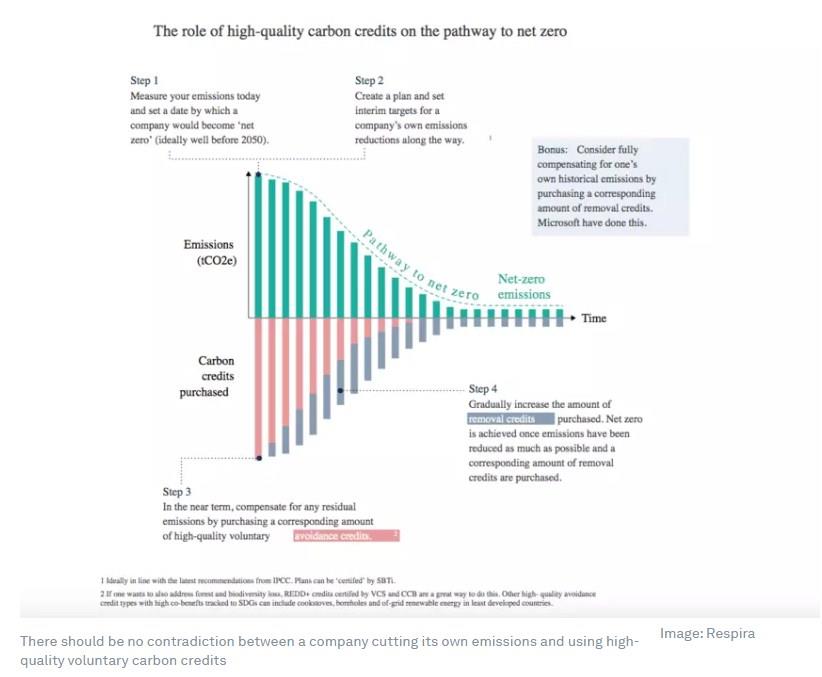by Edward Hewitt*
The world needs to reduce emissions fast to keep within 1.5?C. The science tells us we need to cut global emissions in half by 2030 to be on a pathway to net zero by 2050. It also tells us that one third of cost effective emissions reductions required by 2030 (up to 10Gt per year) can be delivered through natural climate solutions (NCS), which aim to protect, restore and better manage forests, soils and wetlands. The voluntary carbon market (VCM) enables investors, governments, non-governmental organizations and businesses to voluntarily purchase verified emissions reductions in the form of carbon credits. This is a crucial tool to unlock the full potential of NCS, which have traditionally been under-funded and undervalued.
In order for NCS to achieve their full potential, we need to place a financial value on the benefits they provide – such as storing carbon, filtering water, producing oxygen and promoting biodiversity. We also need to unlock vast amounts of private capital. The VCM achieves both of these things through being the first global private market to really value at scale the service an ecosystem provides to the planet – in this case, storing carbon. From years of first-hand personal experience trying to scale NCS, it’s so much easier attracting large flows of private capital now with a vibrant VCM than it was a few years ago. The VCM is by no means the only solution for funding NCS – but is a really important and tangible mechanism we can use right now.
In order for the VCM to function as a source of this much needed finance, trust and integrity are everything. We need to ensure that on the supply side, the underlying carbon credits are of the highest quality (accurate, permanent, additional and with strong benefits for biodiversity and local communities), and on the demand-side we need to avoid ‘greenwashing’ by ensuring those credits do not allow companies to avoid cutting their own emissions. Initiatives such as the Integrity Council for Voluntary Carbon Markets and the Voluntary Carbon Credits Integrity Initiative have already been established to do just that.
Some commentators have suggested that voluntary carbon credits are accelerating environmental collapse. We need to dispel this myth, and build consensus around the role of voluntary carbon credits on the pathway to net zero. The infographic below frames how this should work, and should help to bridge some of the diverging opinions on the subject.

There should be no contradiction between a company cutting its own emissions (in line with science-based targets) and that same company using high-quality voluntary carbon credits to compensate for residual emissions. Emissions reductions in companies’ own supply chains are unlikely to be enough. Using voluntary carbon credits as part of a company’s decarbonisation strategy is an essential tool if we are to limit temperature increases to below 1.5 degrees.
We need to distinguish between the voluntary carbon market, which is designed to compensate for residual emissions (shown below the x axis line in the infographic), and the compliance cap and trade market such as the EU Emissions Trading System, which is designed to drive deeper emissions cuts to companies’ own emissions (shown above the x axis line). These two markets currently play very different roles – although there is the potential that they could converge under new Article 6 rules agreed at COP26 in Glasgow and as compliance regimes such as the Carbon Offsetting and Reduction Scheme for International Aviation scale up.
It’s true that net zero can only be achieved once every company’s emissions have been cut as much as possible, and residual emissions balanced by a corresponding amount of greenhouse gases removed from the atmosphere (these are known as ’removal credits’). But that’s a destination, and currently we are in a process of transition. There’s nothing wrong with compensating along the way with avoidance credits from activities such as forest conservation (known as REDD+), which come with many benefits for people and biodiversity (and offer much larger scale and immediately available emissions reductions right now). This is also in line with the latest scientific guidance to protect, manage and then restore for climate mitigation.
What we need now is a positive and optimistic message. Wouldn’t the world be a better place if every company adopted this vision? Some have labelled it ‘the high ambition path to net zero’, which is an inspiring message. It avoids using the terms ‘carbon neutral’ and ‘offsetting’ which have disputed definitions and have become unhelpfully loaded.
Approaching this issue of how to transition to net zero, we need to keep our language as simple as possible. So much of the debate and discourse around carbon markets is mind-numbingly complex. But in simple terms, NCS are more likely to achieve their potential if they are backed by the power of the VCM and private capital. So let’s get on with the very real challenge of scaling up the real-world projects and programs that turn the theory into practice.
*Director of Natural Climate Solutions, Respira International Ltd
**first published in: www.weforum.org




 By: N. Peter Kramer
By: N. Peter Kramer
